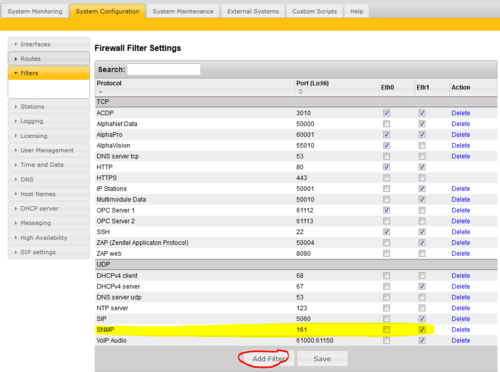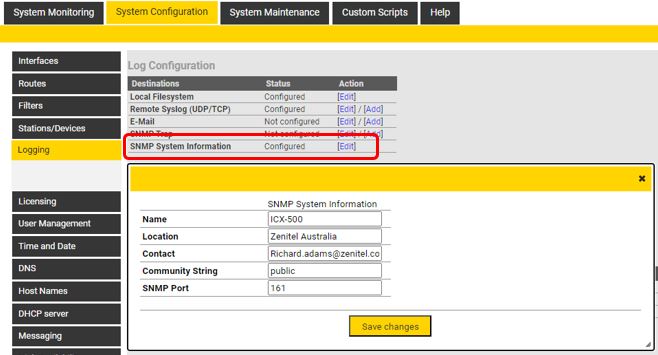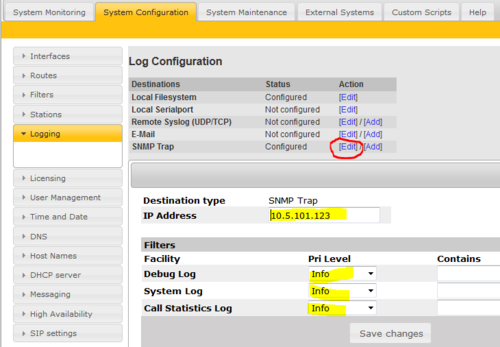SNMP in AlphaCom XE: Difference between revisions
From Zenitel Wiki
ZenitelAus (talk | contribs) No edit summary |
|||
| (58 intermediate revisions by 7 users not shown) | |||
| Line 1: | Line 1: | ||
The AlphaCom XE | {{AI}} | ||
The ICX-AlphaCom and AlphaCom XE run a [[Wikipedia:SNMP|SNMP]] service, and supports SNMP polling and SNMP traps. | |||
The main difference between a SNMP poll and a SNMP trap is which device initiates the communication. An SNMP poll is initiated by the SNMP server and the ICX-AlphaCom responds to the server. An SNMP trap is initiated by the ICX-AlphaCom when it has information to send (usually some event happened) and does not want to wait for the server to ask for information. | |||
== Stentofon MIB OID numbers == | |||
==Stentofon MIB OID numbers== | |||
Zenitel Norway AS has assigned a Private Enterprise Number [http://oid-info.com/get/1.3.6.1.4.1.26122 OID 26122]. | Zenitel Norway AS has assigned a Private Enterprise Number [http://oid-info.com/get/1.3.6.1.4.1.26122 OID 26122]. | ||
The Zenitel Norway AS enterprise number is labeled '''enterprises.stentofon'''<br/> | The Zenitel Norway AS enterprise number is labeled '''enterprises.stentofon'''<br /> | ||
Allocated Sub OIDs: | Allocated Sub OIDs: | ||
| Line 12: | Line 15: | ||
Note that the AlphaCom OID has of historical reasons not always followed the enterprise numbering defined above | Note that the ICX-AlphaCom OID has of historical reasons not always followed the enterprise numbering defined above, see [[SNMP_in_AlphaCom_XE#AlphaCom_MIB_revisions|AlphaCom_MIB_revisions]] | ||
== | ==SNMP poll== | ||
In addition to the [[Downloads#SNMP_MIB_files|AlphaCom MIB]], the standard MIBs [http://tools.ietf.org/html/rfc1213 mibII], [http://net-snmp.sourceforge.net/docs/mibs/ucdavis.html ucd-snmp] and [http://tools.ietf.org/html/rfc3418 snmpv2] are implemented. | |||
These Mibs only implements polled information. | |||
The ICX-AlphaCom MIB implements two main statuses: | |||
{| border="1" | {| border="1" | ||
! style="background:#ffdead;" width="200" | | ! style="background:#ffdead;" width="200" |Variable | ||
! style="background:#ffdead;" width=" | ! style="background:#ffdead;" width="200" |Object ID | ||
! style="background:#ffdead;" width="600" |Comment | |||
|- | |- | ||
| | |Nodestate|| align="center" |1.3.6.1.4.1.26122.1.1.1||AMC-IP status enabled/disabled. Shows if the AlphaCom is operational. Same info as in ICX-Web, Node State - Operational | ||
|- | |- | ||
| | |RTP Statistics|| align="center" |1.3.6.1.4.1.26122.1.2.1||RTP audio statistics | ||
|- | |- | ||
|} | |} | ||
<br> | All MIBs variables are accessed through [[WikiPedia:SNMP#SNMPv2_and_Structure_of_Management_Information|SNMP v2]] protocol with '''community''' = '''public'''. All variables are read only. | ||
The default MIBs are always active, but in order to receive polling requests from an SNMP server you need to open the firewall (Filters) in ICX-Web (UDP port 161). | |||
[[File:SNMP Filters 161.PNG|thumb|left|500px|Define and enable UDP port 161 in '''Filters''' settings in ICX-Web]] | |||
<br style="clear:both;" />You also need to configure the System Information for the SNMP server from System Configuration / Logging / SNMP System Information | |||
[[File:Snmp system info.jpg|left|frame|Configure the System Information for the SNMP Server.]] | |||
<br style="clear:both;" /> | |||
== SNMP Traps == | ==SNMP Traps== | ||
The AlphaCom | The ICX-AlphaCom log events can be sent as SNMP traps. | ||
The alert types that support SNMP traps have a number assigned to them, for example, 1001 is the number assigned to System Log events. The following table lists the number sent in the SNMP trap for each alert type. | The alert types that support SNMP traps have a number assigned to them, for example, 1001 is the number assigned to System Log events. The following table lists the number sent in the SNMP trap for each alert type. | ||
| Line 125: | Line 56: | ||
{| border="1" | {| border="1" | ||
! style="background:#ffdead;" width="120" |Alert number | ! style="background:#ffdead;" width="120" |Alert number | ||
! style="background:#ffdead;" width="200" | | ! style="background:#ffdead;" width="200" |Object ID | ||
! style="background:#ffdead;" width="250" |Alert type | ! style="background:#ffdead;" width="250" |Alert type | ||
! style="background:#ffdead;" width="350" |Alert criteria | ! style="background:#ffdead;" width="350" |Alert criteria | ||
|- | |- | ||
| align=center | 1001 || align=center | 1.3.6.1.4.1.26122.1.11.1001 || [[ | | align="center" |1001|| align="center" |1.3.6.1.4.1.26122.1.11.1001||[[ICX-AlphaCom debug log|Debug log]] events|| | ||
*Software debug information | |||
* Software | |||
|- | |- | ||
| align=center | 1002 || align=center | 1.3.6.1.4.1.26122.1.11.1002 || [[ | | align="center" |1002|| align="center" |1.3.6.1.4.1.26122.1.11.1002||[[System log]] events|| | ||
* Software | *Station Line error | ||
*Board down | |||
*Device/MultiModule (card cage) error | |||
*AGA/AE1 audio line error | |||
*Software error | |||
*[[RCI|Remote Control Input]] on/off | |||
*Customized event logging ([[LOG|LOG command]]) | |||
|- | |- | ||
| align=center | 1003 || align=center | 1.3.6.1.4.1.26122.1.11.1003 || [[Call Statistics Log|Call Statistics log]] events || | | align="center" |1003|| align="center" |1.3.6.1.4.1.26122.1.11.1003||[[Call Statistics Log|Call Statistics log]] events|| | ||
* Point to point calls | *Point to point calls | ||
* Group Calls | *Group Calls | ||
* Call Request | *Call Request | ||
* Ringing Group | *Ringing Group | ||
|- | |- | ||
|} | |} | ||
| Line 151: | Line 82: | ||
SNMP trap is configured in | SNMP trap is configured in ICX-Web, '''System Configuration''' > '''Logging'''. Select destination ‘SNMP Trap’ and configure which logs you want to send. | ||
[[File:SNMP trap.PNG|thumb|left|500px|Configuration of SNMP Traps in | [[File:SNMP trap.PNG|thumb|left|500px|Configuration of SNMP Traps in ICX-Web]] | ||
<br style="clear:both;" /> | <br style="clear:both;" /> | ||
SNMP traps are using UDP port 162. As this is outbound data, there is no need to define this port in the Filters settings in ICX-Web. | |||
==ICX-AlphaCom MIB file== | |||
*Link to [[Downloads#SNMP_MIB_files|download AlphaCom MIB file]] | |||
'''Revision 3:''' | |||
*OID enterprises.26122 | |||
* | *Added missing imports giving MIB validation errors. | ||
* | *Removed some unused import definitions | ||
* | |||
'''Revision 2:''' | |||
*OID enterprises.26122 | |||
*Updated with Zenitel enterprise OID and snmptrap definition for AlphaCom syslog to snmptraps log facilities | |||
'''Revision 1:''' | |||
*OID: enterprises.9362 | |||
* | |||
<br /> | |||
== Related articles == | ==Related articles== | ||
* [[IP | *Link to [[Downloads#SNMP_MIB_files|download MIB files]] | ||
*[[SNMP in IP Stations]] | |||
*Link to a [https://www.manageengine.com/products/mibbrowser-free-tool free MIB Browser], useful for testing | |||
[[Category:Logging]] | [[Category:Logging]] | ||
Latest revision as of 06:06, 7 November 2024
The ICX-AlphaCom and AlphaCom XE run a SNMP service, and supports SNMP polling and SNMP traps.
The main difference between a SNMP poll and a SNMP trap is which device initiates the communication. An SNMP poll is initiated by the SNMP server and the ICX-AlphaCom responds to the server. An SNMP trap is initiated by the ICX-AlphaCom when it has information to send (usually some event happened) and does not want to wait for the server to ask for information.
Stentofon MIB OID numbers
Zenitel Norway AS has assigned a Private Enterprise Number OID 26122.
The Zenitel Norway AS enterprise number is labeled enterprises.stentofon
Allocated Sub OIDs:
- 1 - enterprises.stentofon.alphacom
- 2 - enterprises.stentofon.ipstation
Note that the ICX-AlphaCom OID has of historical reasons not always followed the enterprise numbering defined above, see AlphaCom_MIB_revisions
SNMP poll
In addition to the AlphaCom MIB, the standard MIBs mibII, ucd-snmp and snmpv2 are implemented. These Mibs only implements polled information.
The ICX-AlphaCom MIB implements two main statuses:
| Variable | Object ID | Comment |
|---|---|---|
| Nodestate | 1.3.6.1.4.1.26122.1.1.1 | AMC-IP status enabled/disabled. Shows if the AlphaCom is operational. Same info as in ICX-Web, Node State - Operational |
| RTP Statistics | 1.3.6.1.4.1.26122.1.2.1 | RTP audio statistics |
All MIBs variables are accessed through SNMP v2 protocol with community = public. All variables are read only.
The default MIBs are always active, but in order to receive polling requests from an SNMP server you need to open the firewall (Filters) in ICX-Web (UDP port 161).
You also need to configure the System Information for the SNMP server from System Configuration / Logging / SNMP System Information
SNMP Traps
The ICX-AlphaCom log events can be sent as SNMP traps.
The alert types that support SNMP traps have a number assigned to them, for example, 1001 is the number assigned to System Log events. The following table lists the number sent in the SNMP trap for each alert type.
| Alert number | Object ID | Alert type | Alert criteria |
|---|---|---|---|
| 1001 | 1.3.6.1.4.1.26122.1.11.1001 | Debug log events |
|
| 1002 | 1.3.6.1.4.1.26122.1.11.1002 | System log events |
|
| 1003 | 1.3.6.1.4.1.26122.1.11.1003 | Call Statistics log events |
|
SNMP trap is configured in ICX-Web, System Configuration > Logging. Select destination ‘SNMP Trap’ and configure which logs you want to send.
SNMP traps are using UDP port 162. As this is outbound data, there is no need to define this port in the Filters settings in ICX-Web.
ICX-AlphaCom MIB file
- Link to download AlphaCom MIB file
Revision 3:
- OID enterprises.26122
- Added missing imports giving MIB validation errors.
- Removed some unused import definitions
Revision 2:
- OID enterprises.26122
- Updated with Zenitel enterprise OID and snmptrap definition for AlphaCom syslog to snmptraps log facilities
Revision 1:
- OID: enterprises.9362
Related articles
- Link to download MIB files
- SNMP in IP Stations
- Link to a free MIB Browser, useful for testing




